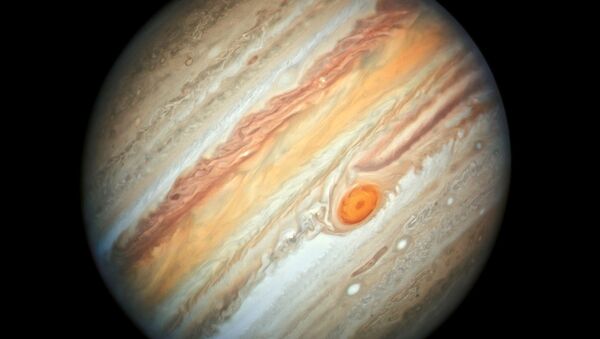وأظهرت الصورة ذات الجودة العالية أكبر كوكب في مجموعتنا الشمسية، كلوحة كثيفة الألوان، بحسب ما نشرته مجلة "ساينس" العلمية.
.@NASAHubble has turned its eye on Jupiter’s Great Red Spot, an Earth-sized storm rolling counterclockwise between the clouds. The color palette in the clouds is more intense than usual, revealing important clues about the planet’s turbulent atmosphere: https://t.co/wYHHJol8tF pic.twitter.com/qYXaSjEODp
— NASA (@NASA) August 8, 2019
التقطت الصورة في 27 حزيران/ يونيو الماضي، كجزء من برنامج "تراث الغلاف الجوي للكواكب"، ولم يتم نشرها إلا الأسبوع الجاري.
What's it's like on Jupiter is hard to imagine. Thanks @NASAHubble for the swirly new close-up. pic.twitter.com/Wf1pXxoY6L
— Chris Hadfield (@Cmdr_Hadfield) August 8, 2019
وتم التقطاها عن طريق كاميرا تلسكوب "Wide Field 3" عندما كان كوكب المشتري على بُعد 400 مليون ميل من الأرض وقبالة الشمس في السماء.
Did you know that two Earths could fit inside Jupiter's iconic Great Red Spot? The powerful storm is one of many colorful features we see in this image captured by our @NASAJuno spacecraft and processed by #CitizenScientist Kevin M. Gill. More: https://t.co/DaLSNvLjRf pic.twitter.com/rrGWZgQlhe
— NASA (@NASA) August 4, 2019
وصرح الخبراء بأن "التفاصيل التي أوضحتها الصورة توفر أدلة جديدة ومهمة حول خصائص الغلاف الجوي للكوكب، وتعتبر أكثر الميزات إثارة للانتباه في الصورة هي ألوان السحب الغنية وهي تتحرك أثناء تشكل عاصفة هائلة على سطح المشتري".
A video of Jupiter taken from Nasa's Juno spacecraft (compiled image) those swirls are clouds and storms happening on the planet,some the bigger ones are bigger than Earth pic.twitter.com/epfTTKBTI6
— Sci-Tech Universe Zone (@scitechofficial) August 8, 2019
وأضافوا أن خطوط الألوان تتشكل اعتمادا على كثافة السُحب واختلاطها ببعضها، الأمر الذي يسبب ظهور ألوان جديدة، وتفصلها الرياح التي تبلغ سرعتها 400 ميل في الساعة.


